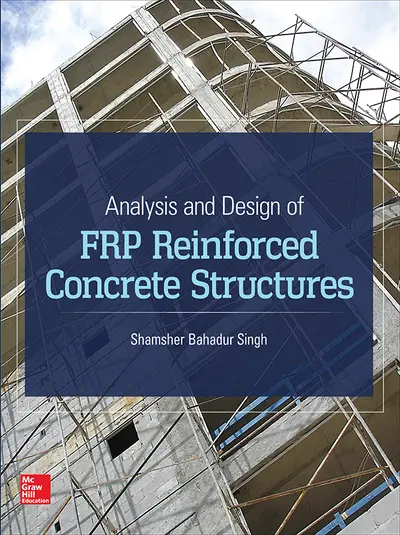My Account Details

ISBN10: 0071847898 | ISBN13: 9780071847896

Step 1 . Download Adobe Digital Editions to your PC or Mac desktop/laptop.
Step 2. Register and authorize your Adobe ID (optional). To access your eBook on multiple devices, first create an Adobe ID at account.adobe.com. Then, open Adobe Digital Editions, go to the Help menu, and select "Authorize Computer" to link your Adobe ID.
Step 3. Open Your eBook. Use Adobe Digital Editions to open the file. If the eBook doesn’t open, contact customer service for assistance.
Publisher's Note: Products purchased from Third Party sellers are not guaranteed by the publisher for quality, authenticity, or access to any online entitlements included with the product. The Most Complete FRP Reinforced Concrete Structure Analysis and Design Guide This comprehensive reference provides proven design procedures for the use of fiber-reinforced polymer (FRP) materials for reinforcement, prestressing, and strengthening of reinforced concrete structures. The characteristics of FRP composite materials as well as the latest manufacturing techniques are discussed. Detailed illustrations and tables, design equations, end-of-chapter problems, and real-world case studies are included in this authoritative resource. Analysis and Design of FRP Reinforced Concrete Structures covers: Material characteristics of FRP bars History and uses of FRP technology Design of RC structures reinforced with FRP bars Design philosophy for FRP external strengthening systems Durability-based design approach for external FRP strengthening of RC beams
1.1. Evolution of FRP Reinforcement
1.2. Review of FRP Composites
1.3. The Importance of the Polymer Matrix
1.3.1. Matrix polymers
1.3.2. Polyester resins
1.3.3. Structural considerations in processing polymer matrix resins
1.3.4. Reinforcing fibers for structural composites
1.3.5. Effects of fiber length on laminate properties
1.3.6. Bonding interphase
1.3.7. Design considerations
1.4. Description of Fibers
1.4.1. Forms of glass fiber reinforcements
1.4.2. Behavior of glass fibers under load
1.4.3. Carbon fibers
1.4.4. Aramid fibers
1.4.5. Other organic fibers
1.4.6. Hybrid reinforcements
1.5. Manufacturing and Processing of Composites
1.5.1. Steps of fabrication scheme
1.5.2. Manufacturing methods
1.6. Sandwich Construction
1.7. Compression Molding
1.8. Multi-Axial Fabric for Structural Components
1.9. Fabrication of Stirrups
1.10. FRP Composites
1.11. FRP Composite Applications
1.12. Composite Mechanics
1.12.1. Laminate terminology
1.12.2. Composite product forms
1.13. Laminates Types and Stacking Sequence
Chapter 2. Material Characteristics of FRP Bars
2.1. Physical and Mechanical Properties
2.2. Physical Properties
2.3. Mechanical Properties and Behavior
2.3.1. Tensile behavior
2.3.2. Compressive behavior
2.3.3. Shear behavior
2.3.4. Bond behavior
2.4. Time-Dependent Behavior
2.4.1. Creep rupture
2.4.2. Fatigue
2.5. Durability
2.6. Recommended Materials and Construction Practices
2.6.1. Strength and modulus grades of FRP bars
2.6.2. Surface geometry, bar sizes, and bar identification
2.7. Construction Practices
2.7.1. Handling and storage of materials
2.7.2. Placement and assembly of materials
2.8. Quality Control and Inspection
Chapter 3. History and Uses of FRP Technology
3.1. FRP Composites in Japan
3.1.1. Development of FRP materials
3.1.2. Development of design methods in Japan
3.1.3. Typical FRP reinforced concrete structures in Japan
3.1.4. FRP for retrofitting and repair
3.1.5. Future uses of FRP
3.1.6. FRP construction activities in Europe
3.2. Reinforced and Prestressed Concrete: Some Applications
3.2.1. Rehabilitation and strengthening
3.2.2. Design guidelines
3.3. FRP Prestressing in the USA
3.3.1. Historical development of FRP tendons
3.3.2. Research and demonstration projects
3.3.3. Future prospects
Chapter 4. Design of RC Structures Reinforced with FRP Bars
4.1. Design Philosophy
4.1.1. Design material properties
4.1.2. Flexural design philosophy
4.1.3. Nominal flexural capacity
4.1.4. Strength reduction factor for flexure (ϕ)
4.1.5. Check for minimum
4.1.6. Serviceability
4.2. Shear
4.2.1. Shear design philosophy
4.2.2. Shear failure modes
4.2.3. Minimum shear reinforcement
4.2.4. Shear failure due to crushing of the web
4.2.5. Detailing of shear stirrups
4.2.6. Punching shear strength of FRP reinforced, two-way concrete slab
4.3. ISIS Canada Design Approach for Flexure
4.3.1. Flexural strength
4.3.2. Serviceability
4.4. Design Approach for CFRP Prestressed Concrete Bridge Beams
4.4.1. Theoretical development of design equations
4.4.2 Deflection and stesses under service load condition
4.4.3. Nonlinear response
E4.1. Design Example 1
E4.2. Design Example 2
E4.3. Design Example 3
E4.4. Design Example 4: A Case Study Problem
E4.5. Design Example 5: Case Study of CFRP Prestressed Concrete Double-T Beam
E4.6. Design Example 6: Case Study of Cfrp Prestressed Concrete Box-Beam
E4.7. Design Example
Chapter 5. Design Philosophy for FRP External Strengthening Systems
5.1. Introduction
5.1.1. Non-prestressed soffit plates
5.1.2. End anchorage for unstressed (non-prestressed) plates
5.1.3. Prestressed soffit
Need support? We're here to help - Get real-world support and resources every step of the way.